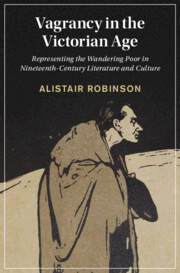 Vagrancy in the Victorian Age
Vagrancy in the Victorian Age Book contents
- Vagrancy in the Victorian Age
- Cambridge Studies in Nineteenth-Century Literature and Culture
- Vagrancy in the Victorian Age
- Copyright page
- Dedication
- Contents
- List of Illustrations
- Acknowledgements
- Introduction
- Part I The Country
- Part II The City
- Part III The Frontier
- Afterword: London 1902
- Bibliography
- Index
- Cambridge Studies in Nineteenth-Century Literature and Culture
Introduction
Published online by Cambridge University Press: 02 November 2021
- Vagrancy in the Victorian Age
- Cambridge Studies in Nineteenth-Century Literature and Culture
- Vagrancy in the Victorian Age
- Copyright page
- Dedication
- Contents
- List of Illustrations
- Acknowledgements
- Introduction
- Part I The Country
- Part II The City
- Part III The Frontier
- Afterword: London 1902
- Bibliography
- Index
- Cambridge Studies in Nineteenth-Century Literature and Culture
Summary
How were vagrants represented in the Victorian period? This chapter argues that the Victorians inherited many strategies of representation from the early modern period, including the moral concept of the deserving and undeserving poor, and stereotypes about the lawlessness, deceptiveness and rebelliousness of wanderers and itinerants. But they were also influenced by new epistemologies and ways of knowing. In particular, Victorian representations of vagrancy were influenced by emerging racial theories, such as extinction theory, degeneration theory, social Darwinism and eugenics. This chapter provides an overview of how these theories interlocked with older prejudices and moral frameworks, and in the process introduces the key vagrant archetypes addressed by this study: Gypsies, hawkers, poachers, casual paupers, loafers, pauper immigrants, American Indians, American vagabonds and beachcombers. Together, these figures comprise the taxonomy through which commentators understood, imagined and interpreted vagrancy in the Victorian age.
Keywords
- Type
- Chapter
- Information
- Vagrancy in the Victorian AgeRepresenting the Wandering Poor in Nineteenth-Century Literature and Culture, pp. 1 - 24Publisher: Cambridge University PressPrint publication year: 2021
